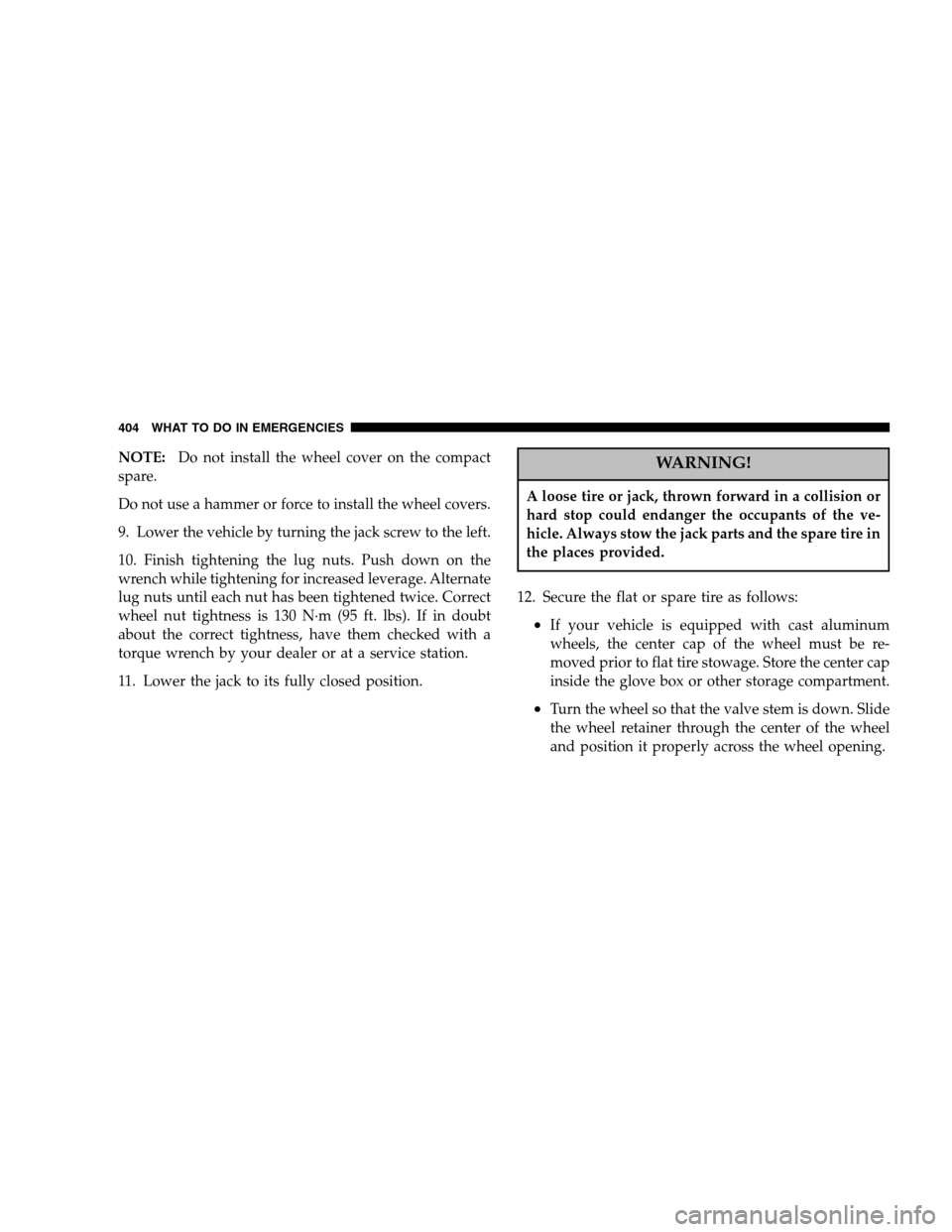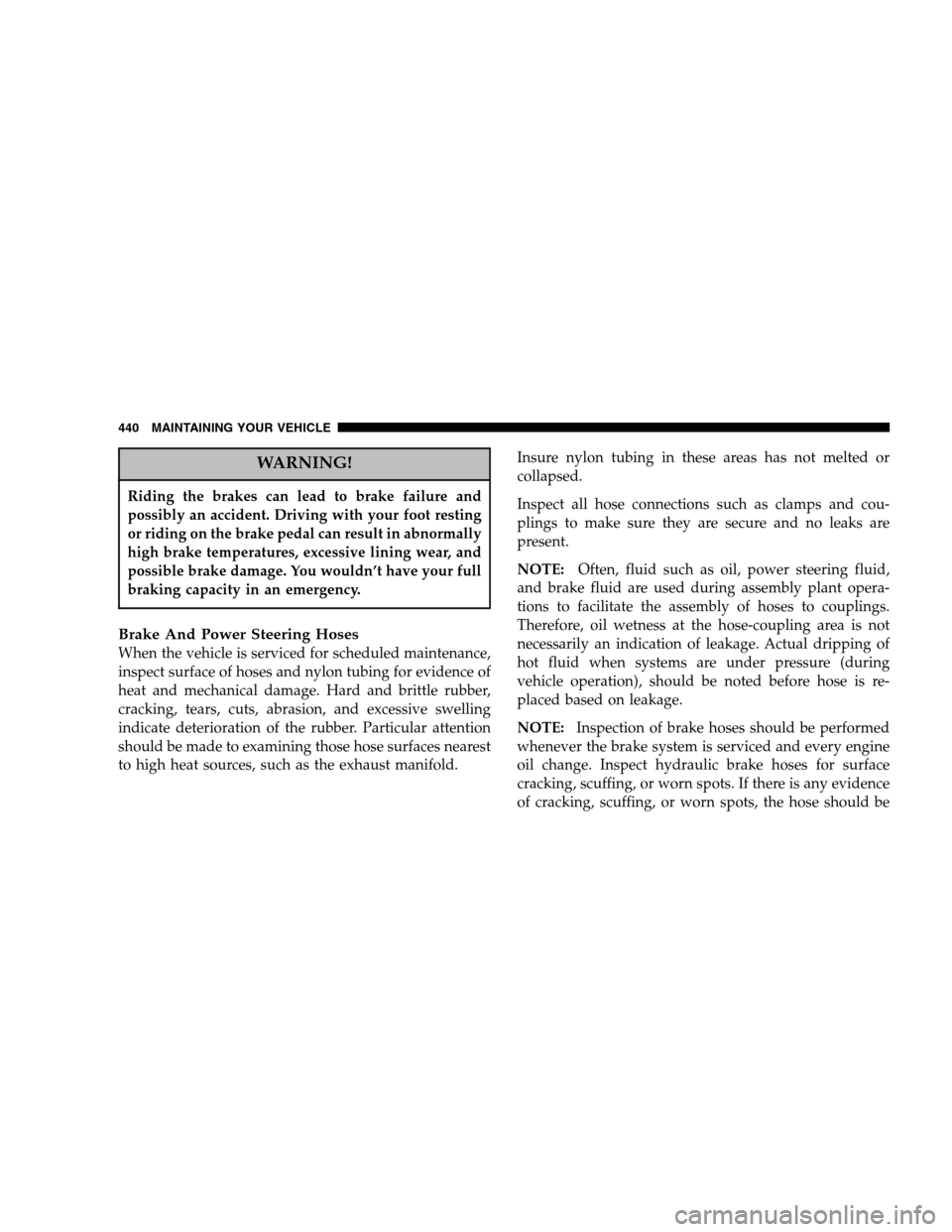Page 404 of 520

NOTE:Do not install the wheel cover on the compact
spare.
Do not use a hammer or force to install the wheel covers.
9. Lower the vehicle by turning the jack screw to the left.
10. Finish tightening the lug nuts. Push down on the
wrench while tightening for increased leverage. Alternate
lug nuts until each nut has been tightened twice. Correct
wheel nut tightness is 130 N·m (95 ft. lbs). If in doubt
about the correct tightness, have them checked with a
torque wrench by your dealer or at a service station.
11. Lower the jack to its fully closed position.WARNING!
A loose tire or jack, thrown forward in a collision or
hard stop could endanger the occupants of the ve-
hicle. Always stow the jack parts and the spare tire in
the places provided.
12. Secure the flat or spare tire as follows:
•If your vehicle is equipped with cast aluminum
wheels, the center cap of the wheel must be re-
moved prior to flat tire stowage. Store the center cap
inside the glove box or other storage compartment.
•Turn the wheel so that the valve stem is down. Slide
the wheel retainer through the center of the wheel
and position it properly across the wheel opening.
404 WHAT TO DO IN EMERGENCIES
Page 405 of 520

•For convenience in checking the spare tire inflation,
stow with the valve stem toward the rear of the
vehicle.
•Using the jack handle, rotate the drive nut to the
right until the wheel is drawn into place against the
underside of the vehicle.
•Continue to rotate the nut until you hear the mecha-
nism click three times. It cannot be overtightened.
Push against the tire several times to be sure it is
securely in place.
13. Stow the jack and jack handle.
14. Check the tire pressure as soon as possible. Correct
pressure as required.
JUMP-STARTING PROCEDURE
WARNING!
•Do not attempt to push or tow your vehicle to get it started.
Vehicles equipped with an automatic transmission cannot be
started this way. Unburned fuel could enter the catalytic con-
verter and once the engine has started, ignite and damage the
converter and vehicle. If the vehicle has a discharged battery,
booster cables may be used to obtain a start from another
vehicle. This type of start can be dangerous if done improperly,
so follow this procedure carefully.
•Battery fluid is a corrosive acid solution; do not allow battery
fluid to contact eyes, skin or clothing. Don’t lean over battery
when attaching clamps or allow the clamps to touch each other.
If acid splashes in eyes or on skin, flush contaminated area
immediately with large quantities of water.
•A battery generates hydrogen gas which is flammable and
explosive. Keep flame or spark away from the vent holes. Do
not use a booster battery or any other booster source with an
output that exceeds 12 volts.
•Take care to avoid the radiator cooling fan whenever the hood
is raised. It can start anytime the ignition switch is on. You can
be hurt by the fan.
WHAT TO DO IN EMERGENCIES 405
6
Page 439 of 520

•Make sure that the radiator and coolant recovery
bottle overflow hoses are not kinked or obstructed.
•Keep the front of the radiator clean. If your vehicle is
equipped with air conditioning, keep the front of the
condenser clean, also.
•Do not change the thermostat for summer or winter
operation. If replacement is ever necessary, install
ONLY the correct type thermostat. Other designs may
result in unsatisfactory coolant performance, poor gas
mileage, and increased emissions.
Hoses And Vacuum/Vapor Harnesses
Inspect surfaces of hoses and nylon tubing for evidence
of heat and mechanical damage. Hard or soft spots,
brittle rubber, cracking, tears, cuts, abrasions, and exces-
sive swelling indicate deterioration of the rubber.
Pay particular attention to those hoses nearest to high
heat sources such as the exhaust manifold. Inspect hose routing to be sure hoses do not come in contact with any
heat source or moving component which may cause heat
damage or mechanical wear.
Insure nylon tubing in these areas has not melted or
collapsed.
Inspect all hose connections such as clamps and cou-
plings to make sure they are secure and no leaks are
present.
Components should be replaced immediately if there is
any evidence of wear or damage that could cause failure.Brakes
In order to assure brake system performance, all brake
system components should be inspected periodically.
Suggested service intervals can be found in the Mainte-
nance Schedules.
MAINTAINING YOUR VEHICLE 439
7
Page 440 of 520

WARNING!
Riding the brakes can lead to brake failure and
possibly an accident. Driving with your foot resting
or riding on the brake pedal can result in abnormally
high brake temperatures, excessive lining wear, and
possible brake damage. You wouldn’t have your full
braking capacity in an emergency.
Brake And Power Steering Hoses
When the vehicle is serviced for scheduled maintenance,
inspect surface of hoses and nylon tubing for evidence of
heat and mechanical damage. Hard and brittle rubber,
cracking, tears, cuts, abrasion, and excessive swelling
indicate deterioration of the rubber. Particular attention
should be made to examining those hose surfaces nearest
to high heat sources, such as the exhaust manifold. Insure nylon tubing in these areas has not melted or
collapsed.
Inspect all hose connections such as clamps and cou-
plings to make sure they are secure and no leaks are
present.
NOTE:
Often, fluid such as oil, power steering fluid,
and brake fluid are used during assembly plant opera-
tions to facilitate the assembly of hoses to couplings.
Therefore, oil wetness at the hose-coupling area is not
necessarily an indication of leakage. Actual dripping of
hot fluid when systems are under pressure (during
vehicle operation), should be noted before hose is re-
placed based on leakage.
NOTE: Inspection of brake hoses should be performed
whenever the brake system is serviced and every engine
oil change. Inspect hydraulic brake hoses for surface
cracking, scuffing, or worn spots. If there is any evidence
of cracking, scuffing, or worn spots, the hose should be
440 MAINTAINING YOUR VEHICLE
Page 456 of 520
NOTE:For lighted switches, see your dealer for replace-
ment instructions.
All of the interior bulbs are glass wedge base or glass
cartridge types. Aluminum base bulbs are not approved
and should not be used for replacement.
LIGHT BULBS — Exterior Bulb Number
Back-up, Tail, Stop, Turn Signal, & Sidemarker . . . 3057
Center High-Mounted Stop Light ............. 921
Fog Light — If Equipped ..................9145
Front Side marker, Park/Turn Signal ........3457AK
Headlight ............................. 9007
License ................................ 168BULB REPLACEMENT
Headlights
1. Remove the three screws securing the headlight mod-
ule.
456 MAINTAINING YOUR VEHICLE
Page 458 of 520
Front Park/Turn Signal and Sidemarker Lights
1. Remove the three screws securing the headlight mod-
ule.
2. Twist the turn signal socket to remove from the
headlight module and pull bulb from socket. 3. Replace bulb, reinstall socket and then reinstall the
headlight module.
458 MAINTAINING YOUR VEHICLE
Page 460 of 520
3. Squeeze the socket assembly tabs to remove it from the
housing.
4. Pull the bulb to remove it from the socket.
5. Replace the bulb, reinstall the socket, and reattach the
light assembly.Center High Mounted Stop Light (CHMSL)
1. Remove the two screws securing the CHMSL.
2. Twist the bulb socket to remove from the CHMSL
housing.
3. Pull the bulb out of the socket.
460 MAINTAINING YOUR VEHICLE
Page 496 of 520

Adding Fuel........................... 357
Adding Washer Fluid .................. 303,432
Additives, Fuel ......................... 355
Adjustable Pedals ....................... 163
Air Conditioner Maintenance ............... 428
Air Conditioning ..................... 278,284
Air Conditioning Controls ................. 278
Air Conditioning Filter .................301,429
Air Conditioning, Operating Tips ............ 301
Air Conditioning, Rear Zone .............286,296
Air Conditioning Refrigerant ............... 428
Air Conditioning System ..........278,284,289,428
Air Conditioning System, Zone Control ........ 279
Air Pressure, Tires ....................... 337
Airbag ................................ 57
Airbag Deployment ....................... 69
Airbag Light ................... 62,63,72,90,214
Airbag Maintenance ....................... 71
Airbag, Window (Side Curtain) ............... 58 Alarm Light
........................... 216
Alarm (Security Alarm) .................... 18
Alignment and Balance ................... 344
Alterations/Modifications, Vehicle ............. 7
Antenna, Satellite Radio ................... 274
Antifreeze (Engine Coolant) ...........435,436,461
Disposal ............................ 437
Anti-Lock Brake System (ABS) .............. 321
Anti-Lock Warning Light .................. 214
Anti-Theft System ........................ 18
Appearance Care ........................ 446
Ashtray ............................... 188
Auto Down Power Windows ................ 33
Automatic Dimming Mirror ................. 96
Automatic Door Locks ................... 29,30
Automatic Headlights .................... 153
Automatic Temperature Control (ATC) ......... 289
Automatic Transaxle .................... 12,315
Interlock System ..................... 15,316
496 INDEX